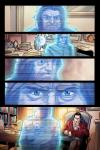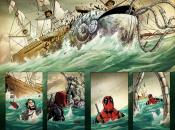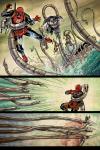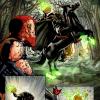|

By Jim Beard
Writer Cullen Bunn’s living an English major’s dream with his latest project. Digging into the world’s greatest works of literature, he’s found a way to present the classics in a whole new light—by introducing them to Deadpool!
DEADPOOL KILLUSTRATED, the follow-up to DEADPOOL KILLS THE MARVEL UNIVERSE, takes great novels and turns them into a killing field for Wade Wilson. We’ve already seen Bunn’s twist on “Moby Dick” in DEADPOOL KILLUSTRATED #1, but, as he reveals, there’s more famous authors to skewer as the four-issue series progresses.
We wanted to know exactly how Bunn approached such a project, how he began to look at the works in DEADPOOL KILLUSTRATED as cannon fodder for the Merc with a Mouth. Also, as Flash Thompson enters into a whole new world of his own, the city of Philadelphia, we slipped in a few questions about Bunn’s other book, VENOM.
Marvel.com: Cullen, what's the origin of the DEADPOOL KILLUSTRATED idea?
Cullen Bunn: When my editor, Jordan D. White, approached me about doing a sequel to DEADPOOL KILLS THE MARVEL UNIVERSE, we batted several ideas around. We wanted this book to take people by surprise, to be something they would never expect. While we talked about many targets for Deadpool’s kill spree, this is the one that we thought would be the most insane.
Marvel.com: How does Wade move from DEADPOOL KILLS THE MARVEL UNIVERSE to DEADPOOL KILLUSTRATED?
Cullen Bunn: In KILLUSTRATED, we learn that Deadpool is continuing his quest to destroy “the Continuity” by murdering all of the heroes and villains of the Marvel Multiverse. Yes, at the end of KILLS THE MARVEL UNIVERSE, he attacked Marvel’s offices, but that was just a decoy set up by the progenitors of all fictional existence. He’s killed Spider-Man and Wolverine and Captain America and all their friends over and over. And he’s getting bored. He decides that the only way to destroy these characters once and for all is to destroy the literary icons that inspired their creation in the first place. So, now he’s waging war against the likes of Moby Dick, Sherlock Holmes, and the Three Musketeers.
Marvel.com: Why these particular classic novels? Are they favorites of yours?
Cullen Bunn: Some of these books are favorites, yes. And I’d be lying if I said in some cases I’m not exorcising some demons left over from my college literature courses. There were a couple of other driving forces, though. First, I wanted Deadpool’s targets to be visually interesting and exciting. Second—and most importantly—I wanted to be able to connect the literary figure to the Marvel character—or characters—he or she might have inspired. Even though Deadpool is rampaging through the works of classic literature, we get to see the connection to the Marvel Universe in a strange way.
Marvel.com: Where and how did you begin to insert Deadpool into the stories? What sort of moments made for the best divergence points?
Cullen Bunn: I didn’t sweat over finding the perfect place in the actual work—be it novel, short story, play, or, believe it or not, poem—for Deadpool to appear. Instead, I approached each of these works as existing in its own pocket universe. So, Don Quixote lives and breathes in his own little world. Captain Nemo lives in his own world. These pocket universes are not supposed to intersect, but something strange is happening. Deadpool’s presence in the “Ideaverse” is causing a collapse. Suddenly, literary characters who were never meant to meet are encountering each other.
Marvel.com: Were there any rules you set for yourself, as far as classic characters not to kill or maim, etc.?
Cullen Bunn: There are no rules. This idea is ridiculous, I know, and Deadpool is traditionally a funny guy. But KILLUSTRATED, like KILLS THE MARVEL UNIVERSE before it, is a horror story. No one is safe.
Marvel.com: Is Deadpool himself actually a fan of classic literature at all? What’s his real beef here?
Cullen Bunn: At first, Deadpool visits the library and tries to read all these classic works to discover the specific correlations with Marvel Universe characters. But he grows dreadfully bored with it and decides to just kill every literary character just to be sure. He’s not a huge fan; although he likes Don Quixote, probably because of their similarities. And he probably kept a copy of “Lady Chatterly’s Lover.”
Marvel.com: In the end, do you feel like you’ve discovered anything new about these stories? Something that may have been illuminated as you tore them apart?
Cullen Bunn: Thinking about these stories in terms of how they might have inspired other characters helped me to really consider what the classic work was about, what the characters might have represented at the time they were written. These are things I might have thought about in college, but that’s been a while, so it was nice to give myself a refresher.
Marvel.com: Any hope that readers of DEADPOOL KILLUSTRATED may then seek out the real books and give them a read?
Cullen Bunn: Absolutely! In this series, I don’t go out of my way to explain who these literary icons are. There are no ID captions identifying Moby Dick and his backstory. You don’t necessarily need to know every detail of these characters to enjoy the series, but if it inspires someone to do a little reading, that’s awesome! I don’t know how often we’ll be able to say that Deadpool inspired someone to read “Little Women,” y’ know?
I would also love to see some high school and college student use this series as the basis of some essays and such. And why stop there? I want college classes focused on this series!
Marvel.com: Looking over the evolution of Deadpool, what do you feel led to this sort of series?
Cullen Bunn: With Deadpool, almost anything can happen. You can tell almost any type of story. And readers expect it. Deadpool also “knows” he’s a fictional character, so that opens lots of doors. If he’s fictional, if the Marvel Universe is fictional, then what about everything else?
Marvel.com: What’s next for you and Deadpool?
Cullen Bunn: I have plans—plans that could take this murderous version of Deadpool places. One of the things that I’ve always thought was funny—and a little sad—is that many readers discount stories such as this because they don’t take place in the main Marvel Universe. They’re not “important.” I’d like to turn that notion on its ear.
Marvel.com: Flash Thompson's finally in Philly in VENOM #31 and 32 - how are you portraying the city? How do you give it its flavor in the book?
Cullen Bunn: At least at first, we’re going to be seeing the city through Flash’s eyes, and this will definitely be a case of “people are strange when you’re a stranger.” My hope is you’ll see the city’s depiction change a little as Flash gets more used to it. Initially, he’s out of his element as both Flash and Venom.
Marvel.com: What will Flash like most about the move?
Cullen Bunn: I think Flash likes the idea of the move more than the move itself. A fresh start sounds great, but relocation is stressful and off-putting and alienating. That’s some of what he’s going through in the beginning. He hasn’t even unpacked his boxes before he starts thinking about moving back home. He’ll need some baby steps to get into the groove of his new home. He’s going to make friends, learn who the quirky people in the neighborhood are, get a new job.
If he survives.
Marvel.com: And then “Toxic,” the new arc in VENOM—how toxic will it be for Flash?
Cullen Bunn: “Toxic” is gonna be a rough storyline for Flash. At first, he’s getting his feet wet, patrolling the city, trying to help people. He’s doing the things a super hero should be doing! But things go south for him in a big way when Eddie Brock shows up with the Toxin symbiote. I’m writing one of the most brutal symbiote throw downs of all time, and even though Flash is the star of the book, it might not go well for him.
|












